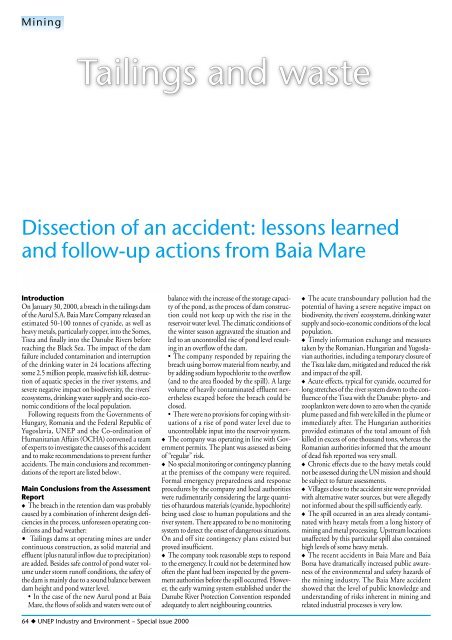Mining and Sustainable Development II - DTIE
Mining and Sustainable Development II - DTIE
Mining and Sustainable Development II - DTIE
You also want an ePaper? Increase the reach of your titles
YUMPU automatically turns print PDFs into web optimized ePapers that Google loves.
<strong>Mining</strong><br />
Tailings <strong>and</strong> waste<br />
Dissection of an accident: lessons learned<br />
<strong>and</strong> follow-up actions from Baia Mare<br />
Introduction<br />
On January 30, 2000, a breach in the tailings dam<br />
of the Aurul S.A. Baia Mare Company released an<br />
estimated 50-100 tonnes of cyanide, as well as<br />
heavy metals, particularly copper, into the Somes,<br />
Tisza <strong>and</strong> finally into the Danube Rivers before<br />
reaching the Black Sea. The impact of the dam<br />
failure included contamination <strong>and</strong> interruption<br />
of the drinking water in 24 locations affecting<br />
some 2.5 million people, massive fish kill, destruction<br />
of aquatic species in the river systems, <strong>and</strong><br />
severe negative impact on biodiversity, the rivers’<br />
ecosystems, drinking water supply <strong>and</strong> socio-economic<br />
conditions of the local population.<br />
Following requests from the Governments of<br />
Hungary, Romania <strong>and</strong> the Federal Republic of<br />
Yugoslavia, UNEP <strong>and</strong> the Co-ordination of<br />
Humanitarian Affairs (OCHA) convened a team<br />
of experts to investigate the causes of this accident<br />
<strong>and</strong> to make recommendations to prevent further<br />
accidents. The main conclusions <strong>and</strong> recommendations<br />
of the report are listed below 1 .<br />
Main Conclusions from the Assessment<br />
Report<br />
◆ The breach in the retention dam was probably<br />
caused by a combination of inherent design deficiencies<br />
in the process, unforeseen operating conditions<br />
<strong>and</strong> bad weather:<br />
• Tailings dams at operating mines are under<br />
continuous construction, as solid material <strong>and</strong><br />
effluent (plus natural inflow due to precipitation)<br />
are added. Besides safe control of pond water volume<br />
under storm runoff conditions, the safety of<br />
the dam is mainly due to a sound balance between<br />
dam height <strong>and</strong> pond water level.<br />
• In the case of the new Aurul pond at Baia<br />
Mare, the flows of solids <strong>and</strong> waters were out of<br />
balance with the increase of the storage capacity<br />
of the pond, as the process of dam construction<br />
could not keep up with the rise in the<br />
reservoir water level. The climatic conditions of<br />
the winter season aggravated the situation <strong>and</strong><br />
led to an uncontrolled rise of pond level resulting<br />
in an overflow of the dam.<br />
• The company responded by repairing the<br />
breach using borrow material from nearby, <strong>and</strong><br />
by adding sodium hypochlorite to the overflow<br />
(<strong>and</strong> to the area flooded by the spill). A large<br />
volume of heavily contaminated effluent nevertheless<br />
escaped before the breach could be<br />
closed.<br />
• There were no provisions for coping with situations<br />
of a rise of pond water level due to<br />
uncontrollable input into the reservoir system.<br />
◆ The company was operating in line with Government<br />
permits. The plant was assessed as being<br />
of “regular” risk.<br />
◆ No special monitoring or contingency planning<br />
at the premises of the company were required.<br />
Formal emergency preparedness <strong>and</strong> response<br />
procedures by the company <strong>and</strong> local authorities<br />
were rudimentarily considering the large quantities<br />
of hazardous materials (cyanide, hypochlorite)<br />
being used close to human populations <strong>and</strong> the<br />
river system. There appeared to be no monitoring<br />
system to detect the onset of dangerous situations.<br />
On <strong>and</strong> off site contingency plans existed but<br />
proved insufficient.<br />
◆ The company took reasonable steps to respond<br />
to the emergency. It could not be determined how<br />
often the plant had been inspected by the government<br />
authorities before the spill occurred. However,<br />
the early warning system established under the<br />
Danube River Protection Convention responded<br />
adequately to alert neighbouring countries.<br />
◆ The acute transboundary pollution had the<br />
potential of having a severe negative impact on<br />
biodiversity, the rivers’ ecosystems, drinking water<br />
supply <strong>and</strong> socio-economic conditions of the local<br />
population.<br />
◆ Timely information exchange <strong>and</strong> measures<br />
taken by the Romanian, Hungarian <strong>and</strong> Yugoslavian<br />
authorities, including a temporary closure of<br />
the Tisza lake dam, mitigated <strong>and</strong> reduced the risk<br />
<strong>and</strong> impact of the spill.<br />
◆ Acute effects, typical for cyanide, occurred for<br />
long stretches of the river system down to the confluence<br />
of the Tisza with the Danube: phyto- <strong>and</strong><br />
zooplankton were down to zero when the cyanide<br />
plume passed <strong>and</strong> fish were killed in the plume or<br />
immediately after. The Hungarian authorities<br />
provided estimates of the total amount of fish<br />
killed in excess of one thous<strong>and</strong> tons, whereas the<br />
Romanian authorities informed that the amount<br />
of dead fish reported was very small.<br />
◆ Chronic effects due to the heavy metals could<br />
not be assessed during the UN mission <strong>and</strong> should<br />
be subject to future assessments.<br />
◆ Villages close to the accident site were provided<br />
with alternative water sources, but were allegedly<br />
not informed about the spill sufficiently early.<br />
◆ The spill occurred in an area already contaminated<br />
with heavy metals from a long history of<br />
mining <strong>and</strong> metal processing. Upstream locations<br />
unaffected by this particular spill also contained<br />
high levels of some heavy metals.<br />
◆ The recent accidents in Baia Mare <strong>and</strong> Baia<br />
Borsa have dramatically increased public awareness<br />
of the environmental <strong>and</strong> safety hazards of<br />
the mining industry. The Baia Mare accident<br />
showed that the level of public knowledge <strong>and</strong><br />
underst<strong>and</strong>ing of risks inherent in mining <strong>and</strong><br />
related industrial processes is very low.<br />
64 ◆ UNEP Industry <strong>and</strong> Environment – Special issue 2000
















